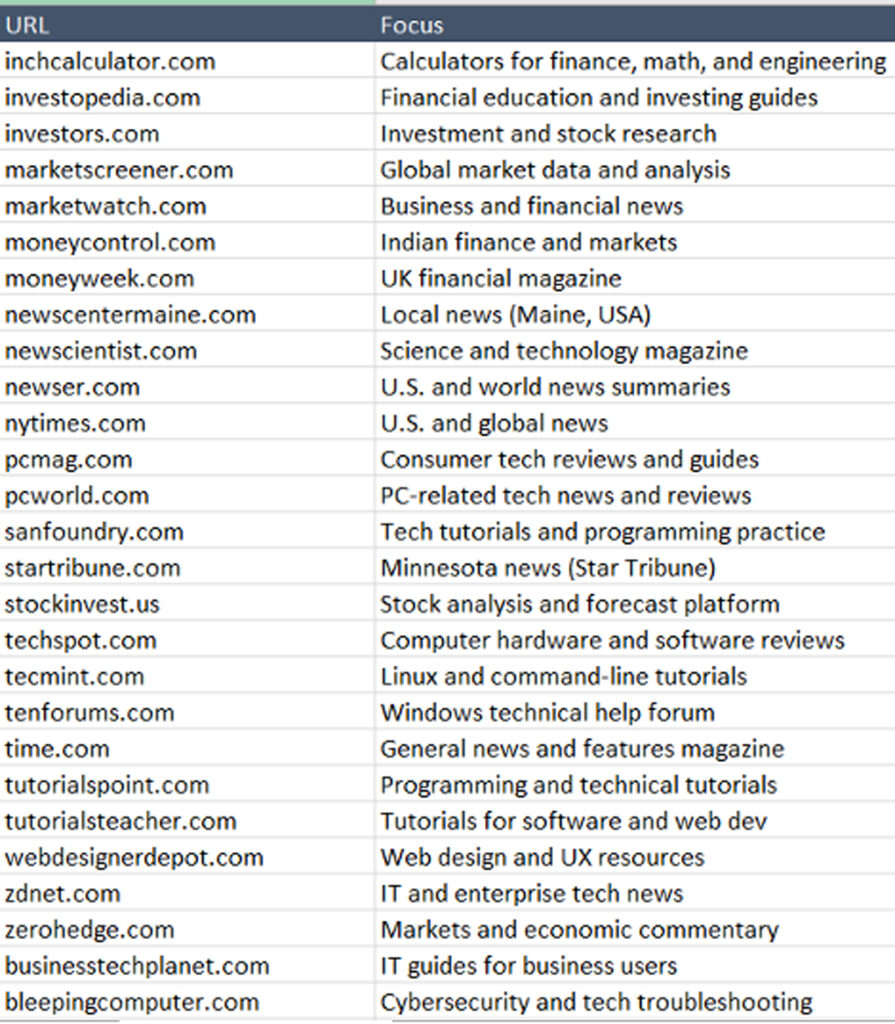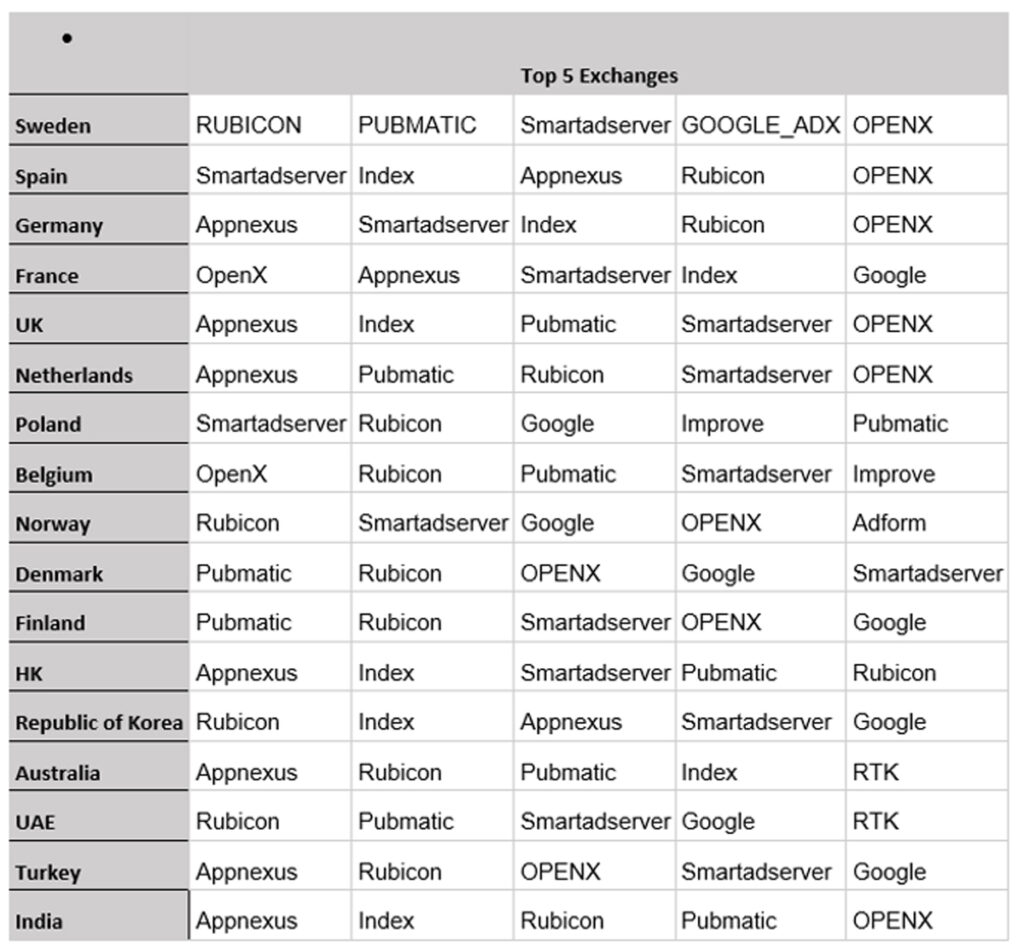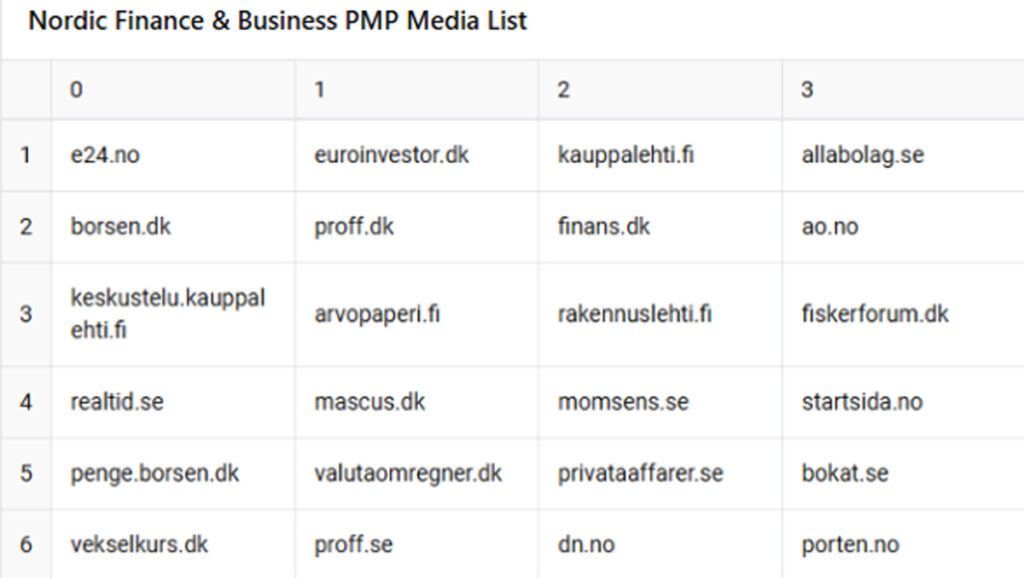1. Core Concepts & Technology
Why use IP targeting?
IP targeting allows us to precisely target users from specific companies by identifying their IP addresses. This ensures we deliver ads only to the relevant B2B audience within your target accounts. IP targeting improves accuracy by focusing on organizational traffic, reducing wasted impressions.
Regional Internet Registries (RIRs), like RIPE or ARIN, manage the allocation of IP address blocks to ISPs, businesses, and organizations. These blocks are publicly registered, linking each IP range to an owning organization.
The data, which includes the organization’s name and sometimes location, enables precise and reliable IP targeting tools.
Is IP targeting stable?
IP targeting is more stable than cookies, which are subject to frequent resets and restrictions due to privacy regulations and browser changes. While not immune to challenges—such as the shift to IPv6 or the use of VPNs—IP targeting is considered a reliable method for B2B marketing. ISPs must regularly update this information for legal, security, and maintenance reasons, providing advertisers with a valuable resource for accurate and relevant business targeting.
Do you use cookie data?
We may use enriched third-party cookies to supplement targeting in markets where it’s compliant with privacy regulations. However, cookies are not the primary method of tracking and targeting in AccountInsight.
Is AccountInsight based on retargeting my company visitors?
By default, AccountInsight focuses on prospecting – identifying and engaging new prospects rather than retargeting visitors to your website. Retargeting can be incorporated to optimize engagement, but it’s not the core of our offering.
How do you deal with hybrid workforces?
- VPN Connection. Employees working from home, when connected via a VPN, emulates company premises. Required for those who deal with restricted data such as engineering /IT, accounting/finance, project management, medical/health, HR/recruiting, and customer service.
- In campaign cookie retargeting. Initially all targeting starts on the company B2B IP addresses. When consent is given by user, a cookie is placed upon receiving bids from publishers.
Enables recognition of individuals who leave the company and reconnect from the same device but different IP addresses. 5% to 10% of the audience can be reached through this method during the campaign window.
What is Strategic Account Based Marketing (ABM)?
Strategic ABM is a personalized approach to reaching key decision-makers across an entire account. Rather than simply targeting specialists, we engage with multiple stakeholders within the organization using a multi-touch approach. This ensures that you influence not just one individual but the broader decision-making team. Strategic ABM is also referred to as “Strategic Account-Based Programmatic.”
What is Intent Based Programmatic?
Intent-based programmatic focuses on identifying individuals within target accounts who are engaging with relevant content. This approach allows us to focus on specialists and key decision-makers who are showing early signs of interest based on the content they engage with. By analyzing the intensity and frequency of these engagements, we can identify companies that are more likely to be in the market for your offerings. This is often referred to as “Real-Time Intent” targeting.
What Makes AccountInsight a B2B DSP?
Even though most of the internet’s advertising infrastructure is built for consumer marketing (B2C), AccountInsight stands apart by being purpose built for B2B – from how it targets companies, to how it manages campaigns, to how it reports results.
You might ask: If there’s no B2B-specific SSP (Supply-Side Platform), and I can target IPs in platforms like The Trade Desk, then how is AccountInsight different?
While the ad inventory comes from the open web (like any DSP), AccountInsight focuses on targeting the right company, not just the right person or audience segment. This means:
- Direct IP Resolution in Real Time: We read the IP address directly from the bid stream and only respond to impressions that match validated B2B IPs. No guessing, no mapping to cookie IDs or devices. Just clean, deterministic, organisation-level targeting.
- Full Account-Level Control: Set impression levels, frequency caps, and creatives per company.
- Account-Based Reporting: See which companies engaged, how often, and with what response – mapped back to your target account list.
General DSPs (like The Trade Desk, Xandr, Adform) may allow IP segments but they have limitations:
- IPs are often abstracted into cookies/device IDs, reducing accuracy (especially outside the US).
- There’s no budget or pacing control per account.
- There’s no audience-level reporting unless managed manually.
- There is performance degradation over time due to throttling or mapping decay.
AccountInsight avoids all of this by going straight to the source: bid stream IP matching with GDPR-compliant resolution, giving you full transparency and reliability.
AccountInsight wasn’t adapted from a B2C platform, it was designed from day one to serve marketers targeting companies. It is account-first, transparent, and privacy-compliant.
2. Targeting & Optimisation
Account Targeting Optimisation
Account optimization occurs at two levels:
- Internally driven: Programmatic teams monitor accounts with high or low traffic to ensure balanced impression delivery. We strive to avoid underperforming accounts that waste resources.
- Customer-driven: Customers have direct access to weekly data via dashboards, allowing them to choose which accounts to prioritize, within the agreed framework.
Media Optimisation
The initial media choice is driven by keywords and content from the landing pages, ensuring relevance to the customer’s offering. Additional media options may be added based on predefined lists or IAB categories. We review media performance weekly and adjust the mix by removing non-relevant or poorly performing sites.
Impressions Optimisation
Impressions are based on agreed monthly targets, and during the early stages of a campaign, we may deliver fewer impressions to refine targeting and optimize the media mix. Impressions will increase progressively as we optimize for the most relevant accounts and media. Programmatic B2B is about quality impressions, not just volume.
What devices and formats are compatible with AccountInsight?
3.1 Supported Devices
Targeting is optimised for desktops and laptops – where most professional activity occurs.
3.2 Mobile, CTV, DOOH
Mobile traffic is deprioritised due to poor IP determinism. Connected TV (CTV) and Digital Out-of-Home (DOOH) are technically possible but not a strategic focus for B2B campaigns.
3.3 Formats Supported
- Display: HTML5, IAB-standard
- Video: In-stream/out-stream, short form (10 sec max recommended)
What Are the Most Effective Use Cases?
3. Compliance & Data Usage
Is your technology GDPR compliant?
AccountInsight is designed with GDPR compliance in mind. We ensure data privacy by processing and storing only the minimum required data. For instance, we collect IP addresses of registered companies, time stamps, and page views, but we do not store personal data or information from cookies.
How is AccountInsight’s B2B DSP compliant with industry regulations?
4. Media & Campaign Execution
Is AccountInsight a media company?
AccountInsight is a fully independent B2B Demand-Side Platform (DSP), separate from any media agencies. While AccountInsight was initially incubated within GroupM, the world’s largest advertising media group, it is not directly affiliated with any media company. AccountInsight operates under Expandi Group, a tech solutions organization that also includes JABMO, Cyance, and B2B Stars, allowing for full autonomy in its operations.
Can you remove media sites if requested?
Yes, media domains, including entire IAB categories, can be excluded upon request. If you already have private deals with specific media sites or are using them in other campaigns, we can accommodate those requirements.
Which AdExchange are you using?
AccountInsight integrates with over 30 global and regional ad exchanges, including OPENX, Rubicon/Magnite, Appnexus/Xandr, PUBMATIC, Google ADX, and SmartAdserver, to provide a wide array of programmatic options for campaign execution.
Can customers implement 3rd party 1×1 pixel tracking?
Yes, we can implement third-party 1×1 pixel tracking to track impressions delivered. For click tracking, we rely on UTM parameters provided by customers, which trigger when a click occurs, enabling independent third-party auditing.
What are AccountInsight’s Media Selection and Optimisation Capabilities?
Media Inventory Access
Over 30 global and local ad exchanges are connected. This enables access to thousands of editorial and business-focused websites around the world.
Media Selection Methods
- White List: Specific sites handpicked (e.g. finance titles)
- IAB Category: Selects media by category, useful for discovering niche or local sources
- Contextual Targeting: Uses keywords to find relevant articles across any media, with brand safety and viewability checks
Media Control
Advertisers can fine-tune which media they appear on:
- Boost: Increase presence on selected sites (higher bid win rate)
- Decrease: Reduce presence
- Pause/Reactivate: Stop or resume on specific domains

Reporting & Optimisation
Full media-level reporting is available, including impressions, clicks, and reach by publication. This transparency supports continuous campaign optimisation.

Using AccountInsight’s B2B IP targeting, ads are delivered to decision-makers within selected companies while they browse trusted, professional media sites like Forbes, Business Insider, CNBC, and ZDNet. These environments offer brand-safe, high-quality content that aligns with business interests, ensuring B2B brands appear in credible, relevant contexts that enhance trust, engagement, and overall campaign effectiveness.
Sites provided for illustration purposes. Actual publications will vary depending on country targeted.

5. Performance & Measurement
Do campaign performance and viewability correlate?
While low viewability can negatively affect performance, in most cases, campaign performance does not directly correlate with viewability. A study by GroupM DK showed that content-rich publishers, despite lower viewability rates, drove more meaningful interactions with the audience. Viewability should be considered one of many campaign metrics, not an absolute KPI.
What is viewability and should I worry about it?
Viewability refers to whether a digital ad is visible on the screen for at least one second by a real human visitor, not a bot. While viewability is important, it’s not the sole determinant of campaign success. For instance, some content-heavy websites may have lower initial viewability but still drive high levels of engagement.
What are the main differences in the reporting vs. traditional cookie solutions?
The key difference is that traditional cookie-based solutions primarily report on the ‘personas’ they targeted, often with limited or no options to guarantee that targeting is focused only on your chosen companies. In contrast, AccountInsight emphasizes transparency by ensuring that you have complete visibility into exactly which companies are being targeted, giving you more control and precision in your B2B campaigns.
What is click validation?
In digital advertising ecosystem, a “click” represents a user interaction with an ad – typically indicating interest and engagement. However, not all clicks are genuine or valuable. Some may come from bots, scanners, or validation tools. At AccountInsight (AI), our objective is to ensure that only real, high-quality user clicks are reported. The following outline explains how we validate clicks to maintain data accuracy and campaign integrity.
- Initial Traffic Filtering
AccountInsight implements proactive traffic filtering before any click is recorded. Our traffic management process blocks invalid traffic from interacting with ads, reducing the volume of suspicious clicks at the source. - Two-Layered Click Tracking
We validate clicks using two independent systems:
- AI DSP (internal bidder system): Tracks impressions and clicks with associated information around the bid transaction and related parameters.
- Third-party monitoring system: An independent service that captures and verifies click-level data.
Clicks confirmed by both systems are considered valid and included in reporting.
- Click Discrepancy Filtering
Clicks are deliberately under-reported if there is uncertainty about their validity. When inconsistencies arise, we investigate by reviewing log-level data, ensuring suspicious activity is excluded. - Filtering Out Test Clicks
Some platforms perform “test clicks” to validate creatives and landing pages. These can mimic real user behavior but do not represent genuine interest. We cross-check click data with impression logs and exclude clicks where the IP or user ID doesn’t match expected patterns. - Click Pattern Monitoring
Our system monitors for irregular click behavior, such as spikes that could indicate scanning activity. Anomalies are flagged and examined in detail. - Adaptive Validation Methodology
Click validation methods evolve continuously to keep up with new behaviors and scanning tools. Although some ad-scanning practices lack transparency, our approach adapts to maintain accuracy in reporting.
How do I troubleshoot impression discrepancies in different platforms?
Impression discrepancies are an expected outcome when using multiple measurement systems. A difference of 5% to 10% is generally acceptable. However, if numbers appear significantly off, especially when using third-party ad servers or tags, it’s worth validating that the implementation and data capture are working correctly. With proper collaboration and data sharing, these issues can typically be resolved quickly and accurately.
Here’s a breakdown of why these differences occur and how to troubleshoot them effectively.
Why Do Impression Discrepancies Happen?
- Timezone Differences: Ensure that both AccountInsight and the third-party reporting tools are using the same timezone when comparing data.
- Incorrect Pixel Implementation: Impression trackers must be implemented either via the “Pixels and Scripts” section in the Creative pane or directly in the HTML using <img src> or <script src>. Incorrect placement can result in zero or inflated counts.
- Auction ID Deduplication: AccountInsight deduplicates impressions by auction ID. If the third-party tool does not deduplicate – or cannot ingest the auction ID via macro – discrepancies will occur.
- Invalid Impression Filtering: Some third-party ad servers (e.g. DCM/Google Campaign Manager) may filter out impressions they classify as invalid. AccountInsight does not apply such filtering at this level, as upstream traffic is already filtered and verified due to our B2B focus.
Impression-Specific Troubleshooting Tips
- Use a debugging tool (e.g. browser dev tools) to check whether impression pixels are firing as expected.
- Confirm the creative is being served and tracked properly across environments.
- Request invalid impression counts or logs from the third-party provider to help isolate discrepancies.
General Troubleshooting Strategy
- Group impression data by relevant fields (e.g. date, creative ID, inventory source, app/site ID, publisher).
- Look for high-percentage differences tied to specific creatives, environments, or platforms.
- Align filters and date ranges between AccountInsight and third-party reporting before comparing.
- If possible, share log-level data including Auction IDs for precise data matching.
How do I troubleshoot click discrepancies in different platforms?
In programmatic advertising, it is common for different systems to report varying numbers of clicks when measuring the same campaign. This discrepancy is especially prevalent when banners are served via external ad servers that apply their own tracking and validation logic.
As discrepancies can occur across platforms for several reasons, below are the most common causes and recommended troubleshooting steps:
- Different Validation Standards: Platforms apply different rules for filtering or validating clicks.
- Test or Scanner Clicks: Creative validation scans by exchanges generate non-user clicks.
- Bot and Invalid Traffic: AccountInsight filters out non-human traffic, which some systems may still count.
- Redirect Chain Issues: Redirect failures or differences in tracking chains can impact click visibility across systems.
- AccountInsight also re-aggregates data for up to 72 hours after receipt, as not all clicks are released by ad exchanges in real time.
Click-Specific Troubleshooting Tips
- Ensure the third-party click tracker is implemented correctly and fires as expected.
- Confirm that the creative is rendering and redirecting properly.
- If using a third-party ad server, verify the correct placement of click macros.
- Remember that AccountInsight counts a maximum of one click per auction ID; multiple clicks during the same session are not be counted.
How Customers Can Help
To assist in resolving discrepancies, we recommend providing the following data:
- Click and impression logs from external ad servers
- Timestamped logs including IP addresses or user IDs (where privacy regulations allow)
- Details of the ad creative’s redirect path setup
- Information on any known scanning or validation tools used during campaign delivery
- Provide side-by-side reports from AccountInsight and third-party platforms, using matching filters and date ranges.
- Break down reports by: Date, Creative ID, Inventory Source, Publisher, Site ID, App ID, and any additional relevant fields.
If possible, share log-level data including AccountInsight Auction IDs for more precise comparison.
6. Platform Capabilities & Reach
What is AccountInsight’s geographical footprint?
AccountInsight works across over 30 exchanges – blending international scale with local specificity. Our PMP (Programmatic Marketplace) team curates access to premium publishers.
Some markets (e.g. Japan, Korea, Vietnam) require partnerships with dominant regional players. Local access doesn’t always mean local execution – it depends on targeting needs and media availability.

Pharma and healthcare often perform better on global English-language sites due to limited programmatic availability of local specialists.
Thousands of business and professional websites are available through direct exchange access, curated white lists, and contextual targeting.
Example: Nordic Finance & Business PMP
In the Nordics, we’ve built specific PMPs with leading finance and business publications, ensuring high-quality reach for B2B brands. Here are just a few examples:





